The benefits of massage are many, and you don’t just need to massage yourself when you have an issue! You can massage yourself regularly as a deep preventative health practice that supports wellness and thriving every day. Self massage is a simple and profound way to regularly connect with your body, give yourself love and care, and support healthy skin.
Abhyanga
Abhyanga, self-massage with oil, is a 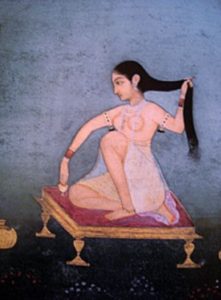 beautiful practice. I personally learned about abhyanga when I discovered Ayurveda. Ayurvedic medicine is an ancient healing system from India. Abhyanga is one of Ayurveda’s many holistic lifestyle practices that supports the body’s own capacity to maintain balance for vitality and healing. In the original language of Ayurveda the word for oil, sneha, literally translates to love! Ayurveda uses oil for everything – cooking and eating, massaging into your skin and hair, cleaning your mouth (oil pulling) and nose (nasya), and more.
beautiful practice. I personally learned about abhyanga when I discovered Ayurveda. Ayurvedic medicine is an ancient healing system from India. Abhyanga is one of Ayurveda’s many holistic lifestyle practices that supports the body’s own capacity to maintain balance for vitality and healing. In the original language of Ayurveda the word for oil, sneha, literally translates to love! Ayurveda uses oil for everything – cooking and eating, massaging into your skin and hair, cleaning your mouth (oil pulling) and nose (nasya), and more.
Tips for massage
Any way that you chose to massage yourself is perfect. Be mindful and notice when you are rushing, judging your body, or not fully allowing yourself to enjoy the sensual pleasure of the oil on your skin. Take a breath, and return to loving touch.
Some specific abhyanga techniques include:
- Warm the oil first – place the bottle in a pot of hot water before use
- Spend at least 10 minutes slowly massaging yourself
- Massage in long, light strokes towards the heart
- Massage in circles around your joints
- Massage your stomach in clockwise circles up on the right, across the top, down on the left, and back around
- Sit down and rub every part of your feet to complete the massage
- Spend extra time on your scalp, ears, and feet when you are able
- Shower after the massage with hot water to open your pores and draw in the oil
- Wash your feet first to avoid slipping in the tub
- You may want a dedicated towel or bathrobe that you don’t mind getting a bit oily
Incorporating self-massage into your routine
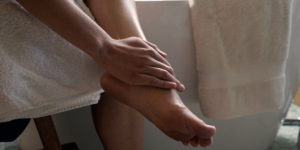 I enjoy self oil massage before or after a shower. Try spending ten to fifteen minutes daily or thirty to forty minutes weekly on your self massage as an addition to your regular routine.
I enjoy self oil massage before or after a shower. Try spending ten to fifteen minutes daily or thirty to forty minutes weekly on your self massage as an addition to your regular routine.
When I feel extra dry, cold, or depleted I like to massage myself before my shower to really draw in the oil. Other times, I enjoy massaging oil into my skin after a shower instead of using lotion. I have even started using oil to clean my face and body and I find I need to use less soap and lotion to feel clean and hydrated. Play around to discover what you enjoy.
I have shared abhyanga with my partner and we support each other to remember to do the practice – he especially loves it post shower after a long run to keep his muscles nourished and warm. Consider using abhyanga as a sacred self care practice for yourself, or share it with a partner or kids as a ritual.
Types of oil
Your skin is extremely absorbent, so anything you put on your skin goes directly into your bloodstream and throughout your body. Therefore, quality matters! Any organic oil will do, the less refined the better, but there is a world of possibility out there.
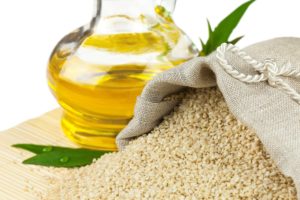
Most commonly, abhyanga is performed with sesame oil. I love using herbal infused sesame oils from Banyan Botanicals. I especially enjoy sesame oil in the fall and winter when it is damp, windy, or cold outside. Sesame oil is thick and luxurious. It deeply penetrates and moisturizes, prevents wrinkles, supports soft and smooth skin, and skin detoxification. Massaging sesame oil into your scalp helps prevent dandruff and hair loss.
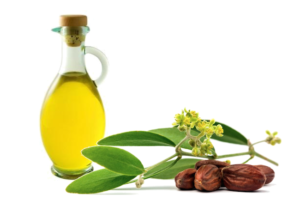 I also absolutely love jojoba oil especially in warmer weather. Jojoba comes from the seed of a shrub native to the southwest and has a mild light nutty scent. It feels light and non-greasy since the pH matches our own sebaceous (oil secreting) glands in our skin. Jojoba is non-toxic, non-allergenic, long lasting, and does not go rancid. Jojoba is also cleansing and often found in natural soaps and shampoos.
I also absolutely love jojoba oil especially in warmer weather. Jojoba comes from the seed of a shrub native to the southwest and has a mild light nutty scent. It feels light and non-greasy since the pH matches our own sebaceous (oil secreting) glands in our skin. Jojoba is non-toxic, non-allergenic, long lasting, and does not go rancid. Jojoba is also cleansing and often found in natural soaps and shampoos.
There is a reason why coconut oil is found in so many bath and beauty products. 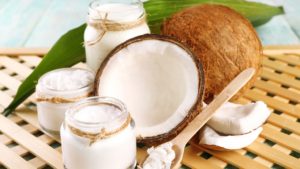 It contains natural antioxidants that soothe or prevent irritated skin and wrinkles. Coconut oil is antifungal, antibacterial, and antiviral and does not go rancid easily. Coconut oil is a low SPF natural sunscreen and a great natural hair conditioner.
It contains natural antioxidants that soothe or prevent irritated skin and wrinkles. Coconut oil is antifungal, antibacterial, and antiviral and does not go rancid easily. Coconut oil is a low SPF natural sunscreen and a great natural hair conditioner.
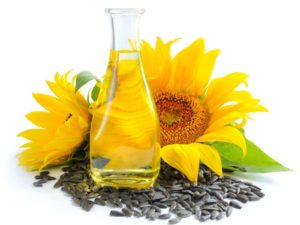 Sunflower oil is light, non greasy, doesn’t smell strong, and absorbs quickly. It protects and smooths your skin. Sunflower oil doesn’t block pores and is good for the face. It supports your skin to retain moisture and fights acne causing bacteria.
Sunflower oil is light, non greasy, doesn’t smell strong, and absorbs quickly. It protects and smooths your skin. Sunflower oil doesn’t block pores and is good for the face. It supports your skin to retain moisture and fights acne causing bacteria.
You can use each oil on its own or use it as a carrier for medicinal herbs or essential oils. You can purchase blends or mix your own. I won’t go into options here because the options are endless! I recommend doing a little research to discover what excites you and experiment. I love using lavender essential oil in my blends to calm my nervous system. Test any new oil, especially with essential oils and herbs, on a small patch of skin on your arm first and wait before applying to your whole body. Then you can be confident your body enjoys it and won’t react.
Follow these links for sources and more information on sesame, jojoba, coconut, and sunflower oil.
Benefits
Abhyanga nourishes you on every level. On the physical level oil massage nourishes, balances, and hydrates the skin, moves lymph, supports digestion, prevents sprain and strain, and helps you sleep. Your nervous system can switch from a stressed state to a parasympathetic state which is required for rest and healing. Abhyanga is said to improve eyesight, strengthen your overall tone, and support healthy aging. On the mental level this practice can quiet an overactive or scattered mind and promote improved self talk. On the emotional and spiritual level abhyanga supports you to protect and define your edges and set clear firm boundaries. The benefits don’t end there – like any dedicated practice, self-massage has boundless possibilities.
What’s stopping you?
When I’ve mentioned my abhyanga practice to others, people are often intrigued. However two main things come up. The first is a comment along the lines of “this sounds interesting but I don’t have time for one more thing in my routine.” Overwhelm and stress are common in our busy time. It is easy for me to let ten minutes pass while scrolling on my phone or thinking about everything I have to do or wish happened differently. When I chose to focus this time on myself, I am calmer, clearer, and better equipped to help others. By stopping and slowing down to massage yourself, you will be more present and balanced. You will free up time in your day and energy in your body by reducing stress and promoting the conditions for your body to rest, repair, and restore itself. The belief that you don’t have enough time itself may shift – this is certainly true for me.
The second comment is, “what if I have oily skin or acne? Adding oil sounds good but only for people with dry skin.” Actually, oily skin, dry skin, and acne are all signs of imbalance. Oil helps re-balance skin. If your skin is dry, it adds hydration. If your skin is oily that means your sebaceous glands are overactive and producing too much oil, which may be caused by drying bath and beauty products. Adding oil can dissolve excess oil present on your skin, since like attracts like, without stripping your skin of the oil it needs. Oil can also soothe irritated skin and re-balance beneficial skin bacteria. I recommend starting with lighter oils like jojoba, sunflower, or even a high quality olive oil if you have acne.
If you are excited about Ayurveda and abhyanga and want to learn more, I love the new book Ayurveda Lifestyle Wisdom by Acharya Shunya. Read the introduction for free here.